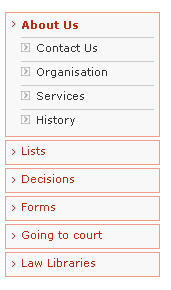

The Tasmanian Government is committed to making information accessible to all members of the Tasmanian community.
Under the Disability Discrimination Act 1992, Australian Government agencies are required to ensure information and services are provided in a non-discriminatory and accessible manner.
For more information about how the Tasmanian Government is improving access to information and services for people with disabilities, read the Tasmanian Government Disability Framework for Action.
Our aim is to be compliant to Level AA of the Web Content Accessibility Guidelines Version 2.1 (WCAG 2.1) standard with some of our content already accessible to level triple A standard of the guidelines.
Web browsers keep track of your online activity through your browser history, cookies and caching. This is so you can find websites you’ve visited before, but it also means other people can see this data.
To protect your privacy, it’s a good idea to clear your browsing history regularly. You can choose to delete everything or only some things.
How to clear your browsing history in:
Private browsing will not log your browsing history or save, or ‘cache', any web pages, images or cookies as you are browsing. Your browser will not remember the pages you visit or your search history.
However, the sites you visited during your current browsing session will record your browsing activity. Your internet service provider will also record this information. Any files you download using private browsing won’t be deleted, so other people can access them if they use your device.
How to enable private browsing in:
This website is fully functional for all modern visual browsers, text-only browsers, screen readers, and mobile devices, and has been found to operate optimally in the latest two versions of Google Chrome, Microsoft Edge, Apple Safari, and Mozilla Firefox. Most of these browsers update themselves to the latest versions automatically.
There are many other web browsers on the market, too many for us to reasonable test. However, most of these have been built on top of the technology of Chrome, Safari or Firefox. If it works in these three, it should work in most other browsers.
We recognise that individuals use the Internet in different ways and our sites provide a variety of pathways to find the information you are looking for.
On the left hand side of the page is a collapsible menu. Clicking on a particular heading (such as About Us in the example) will expand the heading out to a second level. Where applicable second level headings can also be expanded to third level headings.

Our website has navigation features to help you find what you need.
Across the top of every page are links to Home, Contact and Search.
All our pages feature a main navigation menu, with keyboard access as follows:
Our desktop website uses breadcrumbs. These are a series of links showing the trail back to the homepage from wherever you are in the site. Breadcrumbs sit just underneath the top navigation bar on every webpage. To return to the previous page you were viewing, click on the 'Back' button in your browser or use one of the navigation tools to go directly to the page you want.
At the bottom of each page, you will find legal information regarding copyright, privacy and a disclaimer, as well as links to contact us and site map pages.
This website makes proper use of heading tags, allowing screen reader users to easily navigate to the section of the web page they are interested in.
Text can be re-sized or zoomed within the tools or preferences of most standard web browsers, or you can increase and decrease the size using the following key shortcuts:
You can find more information about the tools to make your computer or device easier to use on the AbilityNet website.
This website has forms and publications that may not be in HTML format. To assist users to download and share content, most documents are available in Adobe PDF (PDF) or Microsoft Word (Word) format. Most computers already have the software to open these document formats. However, if your computer does not, you can:
At times, we may publish documents and publications received from third parties and host content on third-party platforms. These documents and platforms may not adhere to the standards followed by the Department of Justice. If you are unable to access this resource via our website, please email us to request an alternative format.
At times, we may publish documents and publications received from third parties and host content on third-party platforms. These documents and platforms may not adhere to the standards followed by the Department of Justice. Therefore we cannot take responsibility for the accessibility of documents provided by third parties.
For other language translations refer to Google Translate, and select from their language list.
The translation links are provided to assist people from non-English speaking backgrounds. However, the Department of Justice is not responsible for the effectiveness of Google Translate.
For help with translating and interpreting go to the Australian Government Department of Home Affairs website